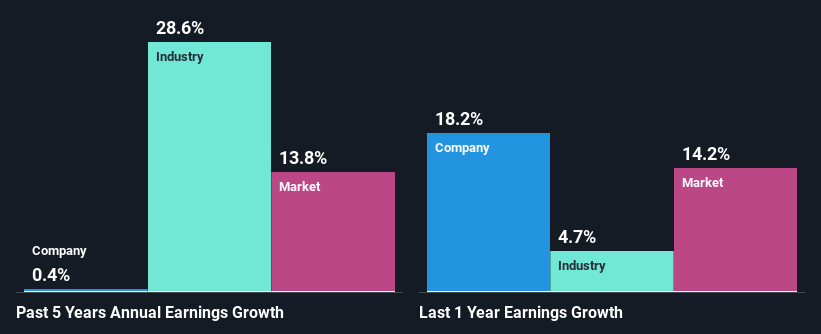- Brazil
- /
- Telecom Services and Carriers
- /
- BOVESPA:VIVT3
Telefônica Brasil S.A.'s (BVMF:VIVT3) On An Uptrend But Financial Prospects Look Pretty Weak: Is The Stock Overpriced?

Most readers would already be aware that Telefônica Brasil's (BVMF:VIVT3) stock increased significantly by 9.2% over the past month. However, in this article, we decided to focus on its weak fundamentals, as long-term financial performance of a business is what ultimately dictates market outcomes. Particularly, we will be paying attention to Telefônica Brasil's ROE today.
Return on equity or ROE is a key measure used to assess how efficiently a company's management is utilizing the company's capital. In other words, it is a profitability ratio which measures the rate of return on the capital provided by the company's shareholders.
Check out our latest analysis for Telefônica Brasil
How To Calculate Return On Equity?
The formula for ROE is:
Return on Equity = Net Profit (from continuing operations) ÷ Shareholders' Equity
So, based on the above formula, the ROE for Telefônica Brasil is:
7.8% = R$5.4b ÷ R$69b (Based on the trailing twelve months to September 2024).
The 'return' refers to a company's earnings over the last year. One way to conceptualize this is that for each R$1 of shareholders' capital it has, the company made R$0.08 in profit.
What Is The Relationship Between ROE And Earnings Growth?
Thus far, we have learned that ROE measures how efficiently a company is generating its profits. Depending on how much of these profits the company reinvests or "retains", and how effectively it does so, we are then able to assess a company’s earnings growth potential. Assuming everything else remains unchanged, the higher the ROE and profit retention, the higher the growth rate of a company compared to companies that don't necessarily bear these characteristics.
A Side By Side comparison of Telefônica Brasil's Earnings Growth And 7.8% ROE
It is quite clear that Telefônica Brasil's ROE is rather low. A comparison with the industry shows that the company's ROE is pretty similar to the average industry ROE of 7.9%. Thus, the low ROE provides some context to Telefônica Brasil's flat net income growth over the past five years.
We then compared Telefônica Brasil's net income growth with the industry and found that the company's growth figure is lower than the average industry growth rate of 29% in the same 5-year period, which is a bit concerning.

Earnings growth is an important metric to consider when valuing a stock. It’s important for an investor to know whether the market has priced in the company's expected earnings growth (or decline). Doing so will help them establish if the stock's future looks promising or ominous. Is VIVT3 fairly valued? This infographic on the company's intrinsic value has everything you need to know.
Is Telefônica Brasil Efficiently Re-investing Its Profits?
Telefônica Brasil has a high three-year median payout ratio of 70% (or a retention ratio of 30%), meaning that the company is paying most of its profits as dividends to its shareholders. This does go some way in explaining why there's been no growth in its earnings.
Moreover, Telefônica Brasil has been paying dividends for at least ten years or more suggesting that management must have perceived that the shareholders prefer dividends over earnings growth. Looking at the current analyst consensus data, we can see that the company's future payout ratio is expected to rise to 90% over the next three years. Still, forecasts suggest that Telefônica Brasil's future ROE will rise to 11% even though the the company's payout ratio is expected to rise. We presume that there could some other characteristics of the business that could be driving the anticipated growth in the company's ROE.
Summary
On the whole, Telefônica Brasil's performance is quite a big let-down. As a result of its low ROE and lack of much reinvestment into the business, the company has seen a disappointing earnings growth rate. With that said, the latest industry analyst forecasts reveal that the company's earnings are expected to accelerate. Are these analysts expectations based on the broad expectations for the industry, or on the company's fundamentals? Click here to be taken to our analyst's forecasts page for the company.
Valuation is complex, but we're here to simplify it.
Discover if Telefônica Brasil might be undervalued or overvalued with our detailed analysis, featuring fair value estimates, potential risks, dividends, insider trades, and its financial condition.
Access Free AnalysisHave feedback on this article? Concerned about the content? Get in touch with us directly. Alternatively, email editorial-team (at) simplywallst.com.
This article by Simply Wall St is general in nature. We provide commentary based on historical data and analyst forecasts only using an unbiased methodology and our articles are not intended to be financial advice. It does not constitute a recommendation to buy or sell any stock, and does not take account of your objectives, or your financial situation. We aim to bring you long-term focused analysis driven by fundamental data. Note that our analysis may not factor in the latest price-sensitive company announcements or qualitative material. Simply Wall St has no position in any stocks mentioned.
About BOVESPA:VIVT3
Telefônica Brasil
Operates as a mobile telecommunications company in Brazil.
Solid track record and good value.
Similar Companies
Market Insights
Community Narratives



